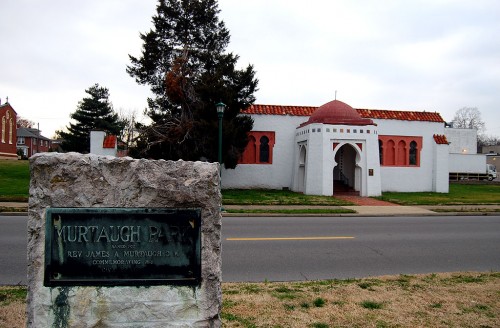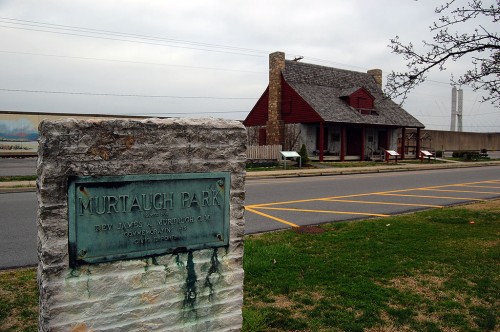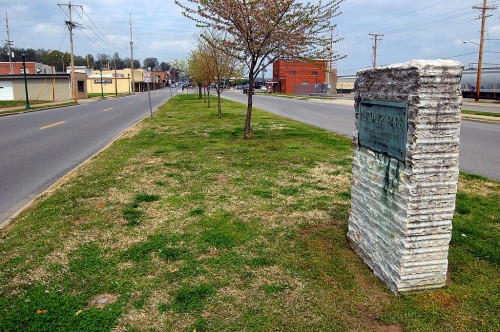I parked the car on Main Street near the Red House to walk across to photograph the Synagogue and St. Vincent’s Church. As I was crossing the median, I almost bumped into a stone monument with a corroded plaque attached to it.
Named for Rev. James A. Murtaugh C.M.
Commemorating His
Civic Efforts
Time goes by after public buildings, streets, parks and bridges are named after someone special and our memories fade or the name becomes just a name, not a memorial. I often say that you live only so long as someone remembers you.
Who was James A. Murtaugh?
And, why did he deserve a skinny sliver of a park? A Google search turns up pretty empty. He was assistant pastor of St. Vincent’s Church (which is visible in this photo) and President of St. Vincent’s College.
 He was known for being active in civic affairs and doing much to reduce friction between the city’s Catholic and Protestants. An Oct. 2, 1934, Missourian article said, “By his activity, he removed all imaginary lines between Catholics and Protestants and developed a united community.”
He was known for being active in civic affairs and doing much to reduce friction between the city’s Catholic and Protestants. An Oct. 2, 1934, Missourian article said, “By his activity, he removed all imaginary lines between Catholics and Protestants and developed a united community.”
He was an early proponent of paving streets and roads. Paving Main Street had the side advantage, I read somewhere, that parishioners could now use the front door of the church without tracking mud inside.
Rev. Murtaugh died in 1916. The Knights of Columbus dedicated the memorial marker Oct. 14, 1928.
Synagogue, Catholic church and Red House
Murtaugh Park is in a perfect historical triangle between the Catholic Church, the Jewish Synagogue and the restoration of Lorimier’s Red House.
In 1958, The Missourian editorialized against a plan to remove the park to create more parking along Main St. The tiny park also memorialized Police Chief N.J. (Jeff) Hutson, who was shot and killed in the line of duty Oct. 7, 1922. The Lion’s Club planted a hawthorn tree in his honor on Arbor Day in 1923.
No big Hawthorne trees
I don’t see any large hawthorn trees north of the Murtaugh monument.
It must have gone the way of a the large, spreading hawthorne tree, “one of the finest specimen of its kind to be found anywhere,” that was planted by the Wednesday Club on April 11, 1923, to honor Miss Amy Husband Kimmel, who founded the club in 1902.
A Southeast Missourian story July 7, 1956, headlined Amy Kimmel Hawthorn, Long Pride of the Community, Is Ruined.
The story goes on to say, “During construction of the new flood control sewer, the east half of the tree was cut or torn away as if some giant knife blade had descended on it, leaving only the west section intact…. For many years it has been one of the show trees of the community. Now, butchered and distorted out of shape, it’s ultimate future is in doubt. At the time of the ceremony, an appropriately inscribed stone was buried beneath the tree. What has become of it?”
Kimmel marker found, relocated
A Missourian follow-up on Oct. 16, 1956, said the stone marker had been found and was going to be moved to a parkway east of the divide between Academic Hall and Kent Library. The Main St. parkway where the tree and marker had been located was paved over after the Kimmel Hawthorn was destroyed.




What is the Red House? I don’t remember there being a house there. Guess we’ll have to check it out when we are in Cape in October. Did you take interior pictures of the synagogue? I’ve always been fascinated with that beautiful building and wondered what it looked like inside.
Margi,
The Red House is a reconstruction of Louis Lorimier’s log structure that was a combination house, trading post, courthouse and community center. A tornado damaged it in 1850 and it was torn down.
The Cape Girardeau Lewis and Clark Bicentennial Commission and the city put up this reproduction. I haven’t looked at it closely. There are enough REAL old buildings in Cape to keep me busy.
No, I didn’t go inside the synagogue. I went to a few services with friends in high school, but haven’t been back inside since then. Maybe that’s something for next trip.
Another update: a reader emailed to say that Chief Hutson’s marker was moved to the Common Pleas Courthouse park and is located between the Courthouse and the fountain.
Here’s a link with a 1965 story about the dedication of the moved marker. In the same edition is an obit for Fred Naeter, one of the three brothers who founded The Missourian.
Hi Ken,
When I was at home last year I just missed a tour given of the synagogue.Perhaps the new owner would be gracious enough to do the same for those of us attending the 60’s reunion.
It seems as if your great site has inspired others to remind us of forgotten people and places. I did not remember the Park Theater,but I remember Hen and Mert Strain. My mom lived and worked with the Strains before she went into the military.
You also inspired me to look in my fathers 1923 central yearbook. I couldn’t remember how many teachers or staff were still at centeal when we were at central. Thought I might bring it to the reunion.I hadn,t thought about Miss Pott in years untill you nudged my memory. She lived next door to us on Themis.
Thanks so much for all your great work and all the wonderful memories.
Jerrette
I wrote a piece about the number of teachers who were in my Dad’s 1931 yearbook and were still around when the Class of 65 rolled through.
Click on the gray link to take you there.
That’s an interesting idea you have to see if anyone could set up a tour of historic buildings while we’re there. I’d much rather do that than tour the new high school.
Wonder if anyone who lives in Cape would like to take that on as a project?
possibly Father Murtaugh was instrumental in St. Vincent’s donating the land for the Jewish Synagogue to be built? Check w/Dr. Frank Nichols. He can tell you.
Bev,
That’s an interesting theory, but I doubt that it happened. Fr. Murtaugh died in 1916 and the Synagogue wasn’t dedicated until 1938.
Of course, anything’s possible. Shoot, I had never heard of Murtaugh until I bumbled onto his monument.
Thank you for including the shot of the Synagogue. I remember going there with the Girl Scouts. Roseanne Hecht was in my troop and I remeber seeing a scroll that I think was covered with jewels. It was beautiful. In one of my childhood Bible story books purchased from a book store near Buckner Ragsdale (I think) was a song, “In the Temple”. It and visits to the Synagogue were special memories of my childhood.
I remember coffee candy that Mrs. Hecht made during the Holy Days too that I sometimes get hungry for.
Does anyone remember the book store I am speaking of? I think a Miss or Mrs. Wagoner was a clerk in it. It might have been near Amy Ewing’s mother’s store.
Isn’t it interesting that when I was a girl the building looked so big. From the picture, it now looks so small. 🙂
Prudy,
You’re probably thinking about Osterloh’s Book Store. I may have some pictures taken inside the store, but I have to make sure that I have the location right.
There was a great smell to that place that no modern book store has managed to capture.
I’m jumping in here a little late, but here are some of my memories of Old St. Vincents. I attended 1-3 grades at the old school. There were 4 classrooms, 2 grades in each. There was a kitchen on the 2nd floor. and eith grade girls served hot lunches to first and second graders at our desks. (Fourth grade was at the “new” school on Ritter Dr.
The first Salk polio vaccines were given to us when I was in 2nd grade. Does anyone remember the days before the polio vaccine? I remember how (pleasantly) surprised I was that the shots didn’t hurt.
During recess we used to play “King of the Mountain” on the hillside to the right of the church (between the church and the synagogue). That hill seemed so high to third graders, and the synagogue was a place of exotic mystery.
Several years ago I went to Mass at the old church. The school had become a parking lot and the church was about half the size of the one I remember. But, as my late brother Roger once said, “To really see what home (or the old church) looked like when you were young, walk around on your knees.”